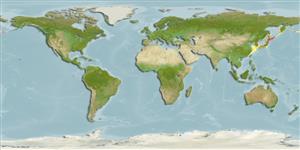Environment: milieu / climate zone / depth range / distribution range
Ecologie
marien demersaal; diepte 0 - 90 m (Ref. 56557), usually 0 - 10 m (Ref. 56557). Temperate
Northwest Pacific: Aomori Prefecture, Japan to the southern Kuril Islands and the northern Sea of Japan (Ref. 559); including Okhotsk Sea at northern Sakhalin (Ref. 51666).
Grootte / Gewicht / Leeftijd
Maturity: Lm ? range ? - ? cm
Max length : 25.0 cm SL mannelijk / geslacht onbekend; (Ref. 559); common length : 11.5 cm TL mannelijk / geslacht onbekend; (Ref. 56557)
Occurs near shore on rocky reefs or silty sand to stone and broken shell bottoms; often among algae to depth of 90 meters (Ref. 51666).
Levenscyclus en paargedrag
Maturities | Voortplanting | Spawnings | Egg(s) | Fecundities | Larven
Masuda, H., K. Amaoka, C. Araga, T. Uyeno and T. Yoshino, 1984. The fishes of the Japanese Archipelago. Vol. 1. Tokai University Press, Tokyo, Japan. 437 p. (text). (Ref. 559)
Status op de Rode Lijst van het IUCN (Ref. 130435)
Gevaar voor de mens
Harmless
Gebruik door de mens
Tools
Speciale rapporten
Download XML
Internetbronnen
Estimates based on models
Preferred temperature (Ref.
123201): 4.6 - 17.9, mean 8.3 °C (based on 229 cells).
Fylogenetische diversiteitsindex (Ref.
82804): PD
50 = 0.6250 [Uniqueness, from 0.5 = low to 2.0 = high].
Bayesian length-weight: a=0.00380 (0.00165 - 0.00876), b=3.16 (2.96 - 3.36), in cm total length, based on LWR estimates for this (Sub)family-body shape (Ref.
93245).
Trofisch niveau (Ref.
69278): 3.2 ±0.45 se; based on food items.
Weerstandsvermogen (Ref.
120179): laag, minimale populatieverdubbelingstijd 4,5-14 jaar (Preliminary K or Fecundity.).
Fishing Vulnerability (Ref.
59153): Low vulnerability (21 of 100).
